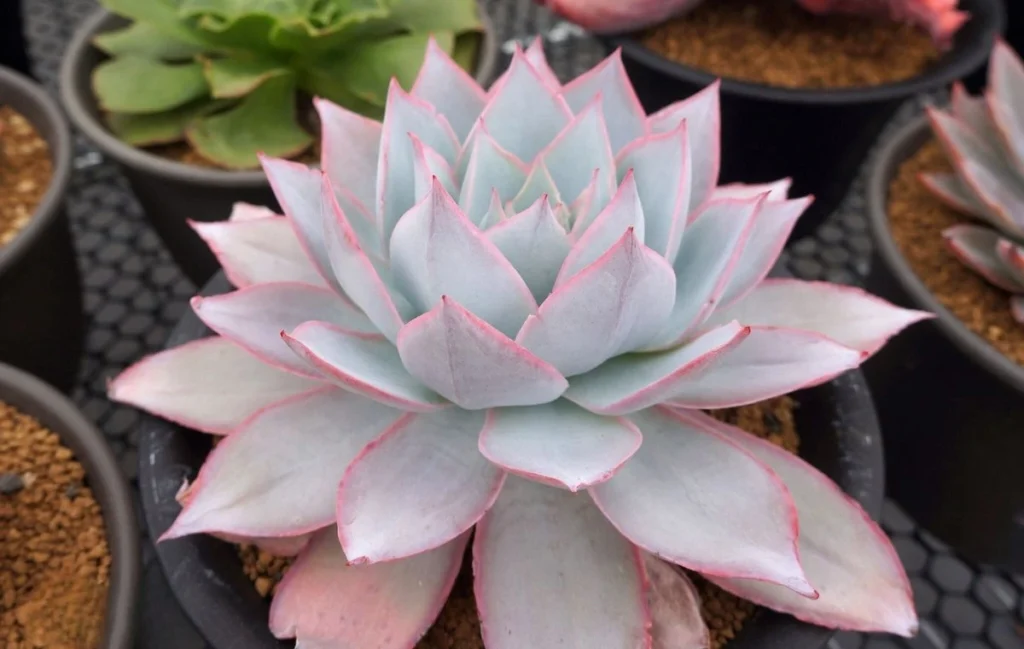White Cloud (Echeveria cante) is an extremely attractive succulent species, notable for its large solitary rosettes and fleshy leaves that display a bluish-green coloration, often adorned with a pinkish hue on the edges. Its easy maintenance, along with stunning beauty, makes it a valuable addition to any succulent collection or landscaping project. It originates from Mexico, specifically from the state of Zacatecas, in the mountains of the Sierra de Chapultepec, situated between Sombrerete and Fresnillo. This mountainous and rocky habitat contributes to the plant’s resilience and cultivation preferences.
The genus name Echeveria honors Atanasio Echeverría y Godoy, a renowned Mexican botanical artist whose illustrations played a crucial role in documenting Mexican flora. The specific epithet “cante” is a tribute to the Cante Botanical Garden and Institute in San Miguel de Allende, Guanajuato, Mexico.

Echeveria cante features solitary, stemless rosettes that can reach up to 12-16 inches (30-40 cm) in diameter. Its leaves are numerous, ranging from 35-50 per rosette, measuring 6-7 inches (15-18 cm) in length and 2.5-3 inches (6.5-7.5 cm) in width. It rarely produces offsets from the base. It is considered a thin-leaved Echeveria, with characteristics resembling Agaves. The leaves are flat to slightly concave above and convex below, without a keel. The leaf coloration is a pale bluish-green with a powdery lavender-white coating (farina), often adorned by a thin red edge on the margins.

The flowers of White Cloud appear at the end of summer, displaying a spectacle of colors, with their floral stems rising above the foliage, adding a dramatic contrast to the already impressive rosette. The inflorescence is erect, pruinose, and red, generally solitary, with a length of 18-24 inches (45-60 cm), bearing orange-pink flowers on the outside and yellow to orange inside.
In landscaping, Echeveria cante is valued for its unique shape and colors. It is often used in rock gardens, xeriscapes (desert-like) and in combinations with other succulents and cacti. Its drought tolerance and low maintenance make it ideal for modern, sustainable, and minimalist gardens, as well as being a popular choice for ornamentation in coastal areas and even in colder climates, thanks to its resistance to temperatures down to 20°F (-6.7°C). With its light colors and bluish hue, it is easy to contrast with other plant species, so that they mutually enhance each other.
Mini gardens and open terrariums are also a creative way to grow White Cloud on a small scale. They can be designed in trays, shallow bowls, or even in bonsai pots, as long as they have good drainage holes, thus creating a miniature landscape that mimics natural scenarios. By adding elements like stones, colored sand, and miniatures, enthusiasts can create enchanting scenes that highlight the beauty of Echeveria cante.
Full sun is ideal for this Mexican succulent, which acquires a thick layer of farina over the leaves, the more hours of sun it receives. Echeveria cante prefers light, airy, and well-drained substrates to avoid root rot, but as it has thinner leaves, with less water storage capacity, it is advisable to add fibrous organic matter to its substrate. Although it is drought tolerant, a moderate watering regimen during the growing season (spring to summer) encourages more robust growth. Fertilize with succulent-specific fertilizers during spring and summer.
In winter, it is recommended to keep the plant drier and protected from freezing temperatures. Removing dead leaves and wilted, dry floral stems helps keep the plant healthy and aesthetically pleasing. Some prefer to remove the floral stems at the beginning of flowering, preventing the appearance of aphids and mealybugs. For consistent growth and substrate renewal, repot your White Cloud every two to three years in the spring, aiming to plant it in a pot at least 1/3 larger than the previous one. Repotting is essential to prevent the natural compaction of the substrate and maintain perfect drainage.
Echeveria cante is resistant to most diseases that affect succulents, being sensitive to aphids that enjoy its floral stem. In case of suspected root rot, do not hesitate to behead the plant, which can save it from death. Propagation of Echeveria cante can be done by seeds, which is the most common method. Propagation by leaf or stem cuttings is possible but may be more challenging compared to other succulents. Allowing the cut to callous before planting can increase the chances of success. In commercial cultivation, in vitro cultivation techniques are employed to produce plants on a large scale.



